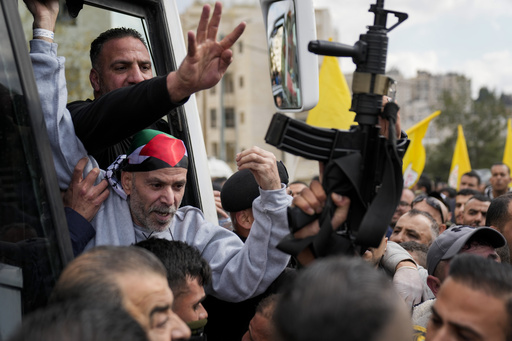
RAMALLAH, West Bank — The recent exchange between Israel and Hamas has resulted in the release of 183 Palestinian prisoners on Saturday, coinciding with the resolution of a ceasefire agreement that has been developing over the past two weeks. This exchange included for the first time detainees from Gaza, as part of an arrangement where Israel vowed to release numerous prisoners provided they were not involved in the Hamas attacks that instigated the latest conflict begun on October 7, 2023.
Among those freed were 111 Palestinians detained in Gaza under suspicions of militancy. They had been held without trial since the aftermath of the conflict’s escalation. Additionally, 72 other individuals, captured before the recent hostilities in either the West Bank or Gaza, were also released after serving long prison terms or life sentences for serious offenses against Israeli citizens. These men, aged between 30 and 66, showcase the human cost of the longstanding conflict.
This prisoner release spotlights the extensive detentions carried out by Israel over the last 15 months as part of its military operations against Hamas in the Gaza Strip. During this period, there has been widespread reporting and images of Israeli forces conducting mass detentions, leading to significant concern from human rights advocates. The Israeli military maintains these arrests are necessary for combating Hamas and other militant organizations.
In the West Bank, family and friends warmly welcomed the newly released prisoners as they arrived in a Red Cross bus from Ofer prison near Ramallah. Enthusiastic crowds chanted praises, celebrating the return of these men who had been absent due to their lengthy detentions. Among the joyful scenes, individuals expressed mixed emotions, recognizing both the joy of reunion and the distress of leaving others behind in captivity.
Seven additional prisoners were also transferred to Egypt, with plans for their deportation. The remaining released prisoners were taken to the European Hospital in Khan Younis, Gaza Strip, where awaited loved ones greeted them with enthusiasm and tears of joy. Distressed family members were seen rushing to reunite with their kin, reflecting the emotional impact of such separations.
Several noteworthy individuals were among those released as a result of the ceasefire agreement. Mohammed el-Halabi, for instance, served as the manager of a prominent Christian aid organization in Gaza. Arrested in 2016, he faced serious allegations of misappropriating funds for Hamas but adamantly denied the accusations. His case drew significant criticism regarding the lack of transparency during his trial, which included prolonged interrogations without legal representation. His release could have implications for humanitarian efforts in the region.
Another released prisoner, Shadi Amouri from Jenin, had been convicted for his role in a deadly bombing that resulted in multiple fatalities. This incident occurred during the second intifada and involved severe consequences for the Israeli public. His family expressed relief at his release, highlighting the complexity of their emotions tied to the situation.
Moreover, Zakaria Zubeidi, a well-known former militant leader who gained notoriety after a dramatic escape from prison in 2021, faced legal issues in connection to alleged violent acts before his release. His transition from a militant identity to a more cultural role has made him a notable figure in Palestinian society.
Multi-time sentenced Mohammed Abu Warda, known for orchestrating suicide bombings, was among those also released into exile, carrying a long history of involvement with Hamas during a tumultuous period in Palestinian history. This release, along with others, reflects the intricate backdrop of both conflict and resolution as lives are interwoven amid deep-seated hostilities.
A significant group involved in earlier deadly attacks also included three brothers from the Abu Hamid family, notorious for their participation in violent actions against Israelis. The repercussions of long-term imprisonment have permeated through generations of their family, drawing attention to the broader narrative of struggle and loss that characterizes many Palestinian families.
Mohammad al-Tous, who had been imprisoned for an extraordinary 39 years after his initial arrest in the 1980s, highlighted the enduring nature of such detainments. His release marked a significant milestone in discussions surrounding prisoners and legacy in an ongoing conflict.
As these events unfold, the complexities of prisoner exchanges and the subsequent emotional ramifications continue to expose the intricacies within the relationship between Israel and the Palestinian territories. The recent releases reflect both a celebration of freedom for some and a sobering reminder of others still behind bars, encapsulated within the persistent struggle for peace and resolution in the region.

